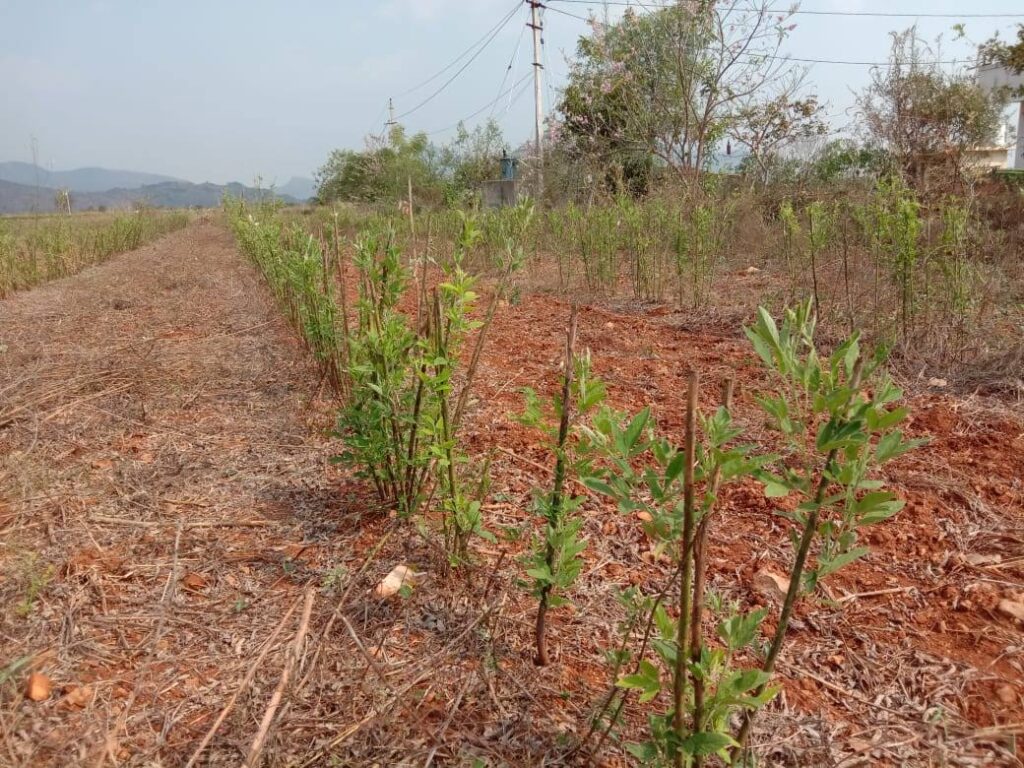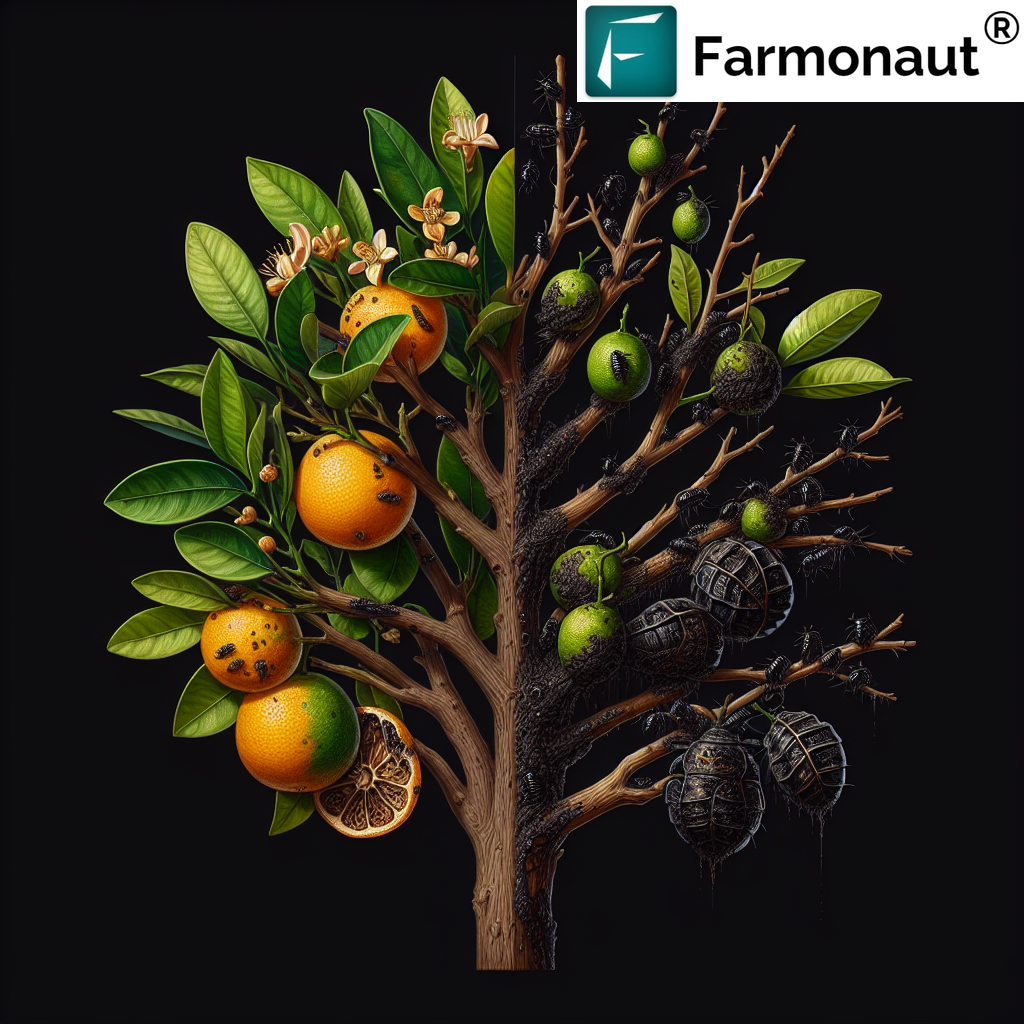Mastering Chili Leaf Curl: Integrated Pest Management Strategies for Sustainable Pepper Cultivation

“Chili leaf curl virus can reduce crop yields by up to 100% if left untreated.”
Welcome to our comprehensive guide on mastering chili leaf curl and implementing integrated pest management strategies for sustainable pepper cultivation. At Farmonaut, we understand the challenges faced by farmers in protecting their valuable chili crops from devastating diseases like the leaf curl virus. In this blog post, we’ll explore effective treatments, both organic and conventional, to combat this persistent threat and ensure healthy, productive pepper plants.
Chili leaf curl virus, primarily spread by whiteflies (Bemisia tabaci), poses a significant risk to pepper cultivation worldwide. As agricultural technology experts, we recognize the importance of combining traditional farming wisdom with cutting-edge solutions to address this issue. Let’s delve into the world of chili leaf curl virus treatment and discover how we can protect our pepper fields using sustainable crop protection methods.
Understanding Chili Leaf Curl Virus
Before we explore treatment options, it’s crucial to understand the nature of the chili leaf curl virus and its impact on pepper plants. This disease, caused by various geminiviruses, is characterized by distinct symptoms that can severely affect crop yield and quality.
Symptoms of Chili Leaf Curl Virus
- Upward curling of leaves: The most noticeable symptom is the upward curling of leaves, giving them a cup-like appearance.
- Stunting: Infected plants often exhibit reduced growth and appear stunted compared to healthy plants.
- Yellowing: Leaves may develop a yellowish tint, indicating chlorosis.
- Reduced fruit set: The virus can significantly impact flower formation and fruit development.
- Deformed fruits: When fruits do form, they may be smaller and misshapen.
The severity of these symptoms can vary depending on factors such as plant age at infection, environmental conditions, and the specific virus strain. Early detection and intervention are crucial for effective management.
Integrated Pest Management for Chili Leaf Curl
To effectively combat chili leaf curl virus, we recommend an integrated pest management (IPM) approach. This strategy combines various control methods to minimize pest populations while reducing reliance on chemical pesticides. Let’s explore the key components of an IPM strategy for managing chili leaf curl:
1. Cultural Practices
Implementing proper cultural practices is the foundation of any successful pest management program. For chili leaf curl virus, consider the following:
- Use disease-resistant varieties: Select chili pepper varieties bred for resistance to leaf curl virus and other common diseases.
- Crop rotation: Rotate peppers with non-host crops to break the disease cycle.
- Field sanitation: Remove and destroy infected plants to prevent the spread of the virus.
- Weed management: Control weeds that may serve as alternative hosts for the virus or whiteflies.
- Proper spacing: Ensure adequate plant spacing to improve air circulation and reduce humidity.
By incorporating these cultural practices, we can create an environment less conducive to virus transmission and whitefly infestation.
2. Pest Monitoring
Regular monitoring is essential for early detection and timely intervention. Implement a robust pest monitoring system:
- Yellow sticky traps: Place these traps throughout the field to monitor whitefly populations.
- Regular scouting: Inspect plants weekly for signs of whiteflies or virus symptoms.
- Threshold-based decision making: Establish action thresholds for implementing control measures.
At Farmonaut, we offer advanced satellite-based crop monitoring solutions that can help detect early signs of stress in your chili fields. Our web app provides real-time insights into crop health, allowing for proactive management decisions.
3. Biological Control
Harnessing nature’s own pest control mechanisms can be an effective and environmentally friendly approach to managing whitefly populations:
- Predatory insects: Introduce natural predators such as ladybugs, lacewings, and predatory mites.
- Parasitic wasps: Encarsia formosa and Eretmocerus eremicus are effective parasitoids of whiteflies.
- Entomopathogenic fungi: Beauveria bassiana and Verticillium lecanii can help control whitefly populations.
Integrating biological control agents into your pest management strategy can provide long-term, sustainable suppression of whitefly populations.
4. Physical and Mechanical Control
Employing physical barriers and mechanical methods can significantly reduce whitefly infestations:
- Reflective mulches: Use silver or aluminum-colored mulches to repel whiteflies.
- Insect-proof screens: Install fine-mesh screens in greenhouses or tunnels to exclude whiteflies.
- Trap crops: Plant attractive crops near peppers to lure whiteflies away from the main crop.
These physical control methods can be particularly effective when combined with other IPM strategies.
Chemical Control Options for Chili Leaf Curl
While we advocate for sustainable and organic approaches, there are situations where chemical control may be necessary. When using insecticides, it’s crucial to rotate between different modes of action to prevent resistance development. Here are some effective chemical options for managing whiteflies and chili leaf curl virus:
- Pyrethroids: Cypermethrin, deltamethrin, and bifenthrin are effective against adult whiteflies.
- Neonicotinoids: Imidacloprid, thiamethoxam, and acetamiprid provide systemic control.
- Insect Growth Regulators: Buprofezine and pyriproxyfen disrupt whitefly development.
- Tetronic acid derivatives: Spiromesifen and spirotetramat are effective against nymphs and eggs.
- Diamides: Cyantraniliprole offers broad-spectrum control of whiteflies and other pests.
Always follow label instructions and local regulations when applying chemical insecticides. Consider the environmental impact and potential effects on beneficial insects when choosing chemical control options.
“Neem oil, an organic pesticide, can effectively control up to 90% of whitefly populations on chili plants.”
Organic Pest Control for Peppers
For farmers seeking organic solutions or those looking to reduce chemical inputs, several effective organic pest control options are available for managing chili leaf curl and whiteflies:
- Neem oil: This natural insecticide disrupts whitefly feeding and reproduction.
- Insecticidal soaps: These products physically suffocate soft-bodied insects like whiteflies.
- Horticultural oils: Mineral or plant-based oils can effectively control whitefly populations.
- Botanical extracts: Garlic, chili pepper, and pyrethrum extracts have insecticidal properties.
- Diatomaceous earth: This fine powder can deter whiteflies and other pests.
When using organic products, consistent application and coverage are key to achieving effective control. Remember that organic doesn’t mean non-toxic – always follow safety guidelines and application instructions.
Preventing Crop Yield Reduction
Preventing crop yield reduction due to chili leaf curl virus requires a proactive and multifaceted approach. Here are some key strategies to implement:
- Early planting: Plant chili peppers early in the season to establish strong plants before peak whitefly activity.
- Proper nutrition: Ensure plants receive balanced nutrition to boost their natural defenses.
- Water management: Avoid water stress, which can make plants more susceptible to pest and disease pressure.
- Companion planting: Intercrop with plants that repel whiteflies or attract beneficial insects.
- Regular monitoring: Use Farmonaut’s satellite-based crop monitoring to detect early signs of stress or disease.
By implementing these preventive measures, we can significantly reduce the risk of yield losses due to chili leaf curl virus.
Comparative Analysis of Chili Leaf Curl Management Strategies
| Management Strategy | Specific Methods | Effectiveness Rating (1-5) | Implementation Difficulty (1-5) | Cost Estimate | Environmental Impact | Long-term Sustainability (1-5) |
|---|---|---|---|---|---|---|
| Cultural Practices | Disease-resistant varieties | 4 | 2 | Medium | Low | 5 |
| Pest Monitoring | Yellow sticky traps, regular scouting | 3 | 3 | Low | Low | 4 |
| Chemical Control | Cypermethrin, Imidacloprid | 5 | 2 | High | High | 2 |
| Organic Control | Neem oil, predatory mites | 3 | 4 | Medium | Low | 4 |
| Physical Control | Reflective mulches, insect-proof screens | 3 | 3 | Medium | Low | 4 |
This comparative analysis provides a quick overview of different management strategies for chili leaf curl virus. While chemical control may offer the highest immediate effectiveness, organic and cultural practices provide more sustainable long-term solutions with lower environmental impact.
Agritech Solutions for Plant Diseases
At Farmonaut, we believe in harnessing the power of technology to revolutionize agricultural practices. Our advanced satellite-based crop monitoring system offers valuable insights for managing plant diseases like chili leaf curl virus:
- Early detection: Our satellite imagery can identify stress patterns in crops before they’re visible to the naked eye.
- Precision application: Use our vegetation health maps to target pest control efforts more efficiently.
- Data-driven decisions: Access historical and real-time data to make informed management choices.
- Weather forecasting: Plan pest control activities based on accurate, field-specific weather predictions.
By integrating Farmonaut’s agritech solutions into your pest management strategy, you can enhance the effectiveness of your efforts while optimizing resource use.
Sustainable Crop Protection Methods
As we look to the future of agriculture, sustainable crop protection methods are becoming increasingly important. Here are some innovative approaches to consider:
- Biopesticides: Explore naturally derived pesticides that have minimal environmental impact.
- RNA interference (RNAi): This emerging technology can target specific pests without affecting beneficial insects.
- Plant-mediated pest management: Enhance plants’ natural defense mechanisms through breeding or genetic modification.
- Conservation biological control: Create habitats that support natural enemy populations year-round.
- Precision agriculture: Use Farmonaut’s satellite data to optimize pesticide application and reduce overall usage.
By adopting these sustainable methods, we can protect our chili crops while preserving the long-term health of our agricultural ecosystems.
FAQs: Chili Leaf Curl Management
Q: Can chili leaf curl virus spread to other crops?
A: While chili leaf curl virus primarily affects peppers and other Solanaceae family members, some strains can infect other crops. It’s best to practice crop rotation and maintain field hygiene to prevent spread.
Q: How quickly does chili leaf curl virus spread?
A: The spread of chili leaf curl virus can be rapid, especially in the presence of high whitefly populations. Early detection and swift action are crucial for containment.
Q: Are there any home remedies for treating chili leaf curl?
A: While professional treatments are more reliable, some home remedies like neem oil sprays or milk solutions can help manage mild infestations. However, these should be used in conjunction with other IPM strategies for best results.
Q: How can I differentiate between chili leaf curl virus and nutrient deficiencies?
A: Chili leaf curl virus typically causes upward curling of leaves and stunted growth, while nutrient deficiencies often result in yellowing or other color changes. When in doubt, consult with a plant pathologist or use Farmonaut’s advanced crop monitoring tools for accurate diagnosis.
Q: Can chili plants recover from leaf curl virus?
A: Once infected, chili plants cannot be cured of the virus. However, early management can help minimize yield loss and prevent spread to healthy plants.
Conclusion: Empowering Farmers with Knowledge and Technology
Mastering chili leaf curl management requires a comprehensive approach that combines traditional farming wisdom with cutting-edge technology. By implementing integrated pest management strategies, leveraging sustainable crop protection methods, and utilizing advanced agritech solutions like those offered by Farmonaut, farmers can effectively combat this challenging disease.
Remember, successful management of chili leaf curl virus is not just about treating symptoms – it’s about creating a resilient agricultural ecosystem that can withstand pest pressures while maintaining productivity. Whether you choose organic pest control for peppers or opt for conventional insecticides, the key lies in informed decision-making and proactive management.
We invite you to explore Farmonaut’s suite of agricultural technology solutions to enhance your pepper cultivation practices. Our satellite-based crop monitoring, AI-powered advisory systems, and data-driven insights can provide you with the tools you need to take your chili production to the next level.
Ready to revolutionize your approach to chili cultivation? Check out our web app, Android app, or iOS app to get started. For developers interested in integrating our powerful agricultural data into their own systems, explore our API and API Developer Docs.
Together, let’s build a more sustainable and productive future for pepper cultivation!




















